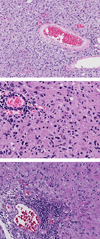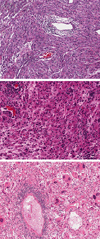Tumor-infiltrating lymphocytes in glioblastoma are associated with specific genomic alterations and related to transcriptional class - PubMed (original) (raw)
. 2013 Sep 15;19(18):4951-60.
doi: 10.1158/1078-0432.CCR-13-0551. Epub 2013 Jul 17.
Jun Kong, Jingjing Gao, David A Gutman, Lee A D Cooper, Christina Appin, Yuna Park, Lisa Scarpace, Tom Mikkelsen, Mark L Cohen, Kenneth D Aldape, Roger E McLendon, Norman L Lehman, C Ryan Miller, Matthew J Schniederjan, Cameron W Brennan, Joel H Saltz, Carlos S Moreno, Daniel J Brat
Affiliations
- PMID: 23864165
- PMCID: PMC3865611
- DOI: 10.1158/1078-0432.CCR-13-0551
Tumor-infiltrating lymphocytes in glioblastoma are associated with specific genomic alterations and related to transcriptional class
W Caleb Rutledge et al. Clin Cancer Res. 2013.
Abstract
Purpose: Tumor-infiltrating lymphocytes (TIL) have prognostic significance in many cancers, yet their roles in glioblastoma have not been fully defined. We hypothesized that TILs in glioblastoma are associated with molecular alterations, histologies, and survival.
Experimental design: We used data from The Cancer Genome Atlas (TCGA) to investigate molecular, histologic, and clinical correlates of TILs in glioblastomas. Lymphocytes were categorized as absent, present, or abundant in histopathologic images from 171 TCGA glioblastomas. Associations were examined between lymphocytes and histologic features, mutations, copy number alterations, CpG island methylator phenotype, transcriptional class, and survival. We validated histologic findings using CD3G gene expression.
Results: We found a positive correlation between TILs and glioblastomas with gemistocytes, sarcomatous cells, epithelioid cells, and giant cells. Lymphocytes were enriched in the mesenchymal transcriptional class and strongly associated with mutations in NF1 and RB1. These mutations are frequent in the mesenchymal class and characteristic of gemistocytic, sarcomatous, epithelioid, and giant cell histologies. Conversely, TILs were rare in glioblastomas with small cells and oligodendroglioma components. Lymphocytes were depleted in the classical transcriptional class and in EGF receptor (EGFR)-amplified and homozygous PTEN-deleted glioblastomas. These alterations are characteristic of glioblastomas with small cells and glioblastomas of the classical transcriptional class. No association with survival was shown.
Conclusions: TILs were enriched in glioblastomas of the mesenchymal class, strongly associated with mutations in NF1 and RB1 and typical of histologies characterized by these mutations. Conversely, TILs were depleted in the classical class, EGFR-amplified, and homozygous PTEN-deleted tumors and rare in histologies characterized by these alterations.
©2013 AACR.
Conflict of interest statement
Conflict of interest: The authors have no conflicts of interest.
Figures
Figure 1
Representative examples of permanent section histologic slides from TCGA cases. Lymphocytes were identified as small round cells with scant cytoplasm and darkly staining nuclei. Cases with a complete absence of lymphocytes were labeled 0 (absent) (top). Cases with lymphocytes present in <50% of tumor tissue were categorized 1+ (present) (middle).Cases with lymphocytes present in ≥50% were categorized 2+ (abundant) (bottom).
Figure 2
Representative examples of GBM morphologic subtypes associated with the presence of lymphocytes in TCGA permanent section histologic slides. TILs are enriched in GBMs with sarcomatous cells (top), gemistocytes (middle) and giant cells (bottom).
Figure 3
Kaplan–Meier estimates of survival according to absent (0), present (1+) or abundant (2+) lymphocytes. TILs are not associated with improved survival (log-rank p>0.05).
Similar articles
- Epidermal Growth Factor Receptor Variant III (EGFRvIII) Positivity in _EGFR_-Amplified Glioblastomas: Prognostic Role and Comparison between Primary and Recurrent Tumors.
Felsberg J, Hentschel B, Kaulich K, Gramatzki D, Zacher A, Malzkorn B, Kamp M, Sabel M, Simon M, Westphal M, Schackert G, Tonn JC, Pietsch T, von Deimling A, Loeffler M, Reifenberger G, Weller M; German Glioma Network. Felsberg J, et al. Clin Cancer Res. 2017 Nov 15;23(22):6846-6855. doi: 10.1158/1078-0432.CCR-17-0890. Epub 2017 Aug 29. Clin Cancer Res. 2017. PMID: 28855349 - Molecular differences in IDH wildtype glioblastoma according to MGMT promoter methylation.
Kessler T, Sahm F, Sadik A, Stichel D, Hertenstein A, Reifenberger G, Zacher A, Sabel M, Tabatabai G, Steinbach J, Sure U, Krex D, Grosu AL, Bewerunge-Hudler M, Jones D, Pfister SM, Weller M, Opitz C, Bendszus M, von Deimling A, Platten M, Wick W. Kessler T, et al. Neuro Oncol. 2018 Feb 19;20(3):367-379. doi: 10.1093/neuonc/nox160. Neuro Oncol. 2018. PMID: 29016808 Free PMC article. - Long-term survival in primary glioblastoma with versus without isocitrate dehydrogenase mutations.
Hartmann C, Hentschel B, Simon M, Westphal M, Schackert G, Tonn JC, Loeffler M, Reifenberger G, Pietsch T, von Deimling A, Weller M; German Glioma Network. Hartmann C, et al. Clin Cancer Res. 2013 Sep 15;19(18):5146-57. doi: 10.1158/1078-0432.CCR-13-0017. Epub 2013 Aug 5. Clin Cancer Res. 2013. PMID: 23918605 - Population-based studies on incidence, survival rates, and genetic alterations in astrocytic and oligodendroglial gliomas.
Ohgaki H, Kleihues P. Ohgaki H, et al. J Neuropathol Exp Neurol. 2005 Jun;64(6):479-89. doi: 10.1093/jnen/64.6.479. J Neuropathol Exp Neurol. 2005. PMID: 15977639 Review. - EGFR as a clinical marker in glioblastomas and other gliomas.
Saadeh FS, Mahfouz R, Assi HI. Saadeh FS, et al. Int J Biol Markers. 2018 Jan;33(1):22-32. doi: 10.5301/ijbm.5000301. Int J Biol Markers. 2018. PMID: 28885661 Review.
Cited by
- The Role of Mesenchymal Reprogramming in Malignant Clonal Evolution and Intra-Tumoral Heterogeneity in Glioblastoma.
Wu Q, Berglund AE, Macaulay RJ, Etame AB. Wu Q, et al. Cells. 2024 May 30;13(11):942. doi: 10.3390/cells13110942. Cells. 2024. PMID: 38891074 Free PMC article. Review. - Non-targeted effects of radiation therapy for glioblastoma.
Lerouge L, Ruch A, Pierson J, Thomas N, Barberi-Heyob M. Lerouge L, et al. Heliyon. 2024 May 9;10(10):e30813. doi: 10.1016/j.heliyon.2024.e30813. eCollection 2024 May 30. Heliyon. 2024. PMID: 38778925 Free PMC article. Review. - Immune Checkpoint Inhibitors and Glioblastoma: A Review on Current State and Future Directions.
Ser MH, Webb MJ, Sener U, Campian JL. Ser MH, et al. J Immunother Precis Oncol. 2024 May 2;7(2):97-110. doi: 10.36401/JIPO-23-34. eCollection 2024 May. J Immunother Precis Oncol. 2024. PMID: 38721406 Free PMC article. - Systemic and local immunosuppression in glioblastoma and its prognostic significance.
Stepanenko AA, Sosnovtseva AO, Valikhov MP, Chernysheva AA, Abramova OV, Pavlov KA, Chekhonin VP. Stepanenko AA, et al. Front Immunol. 2024 Feb 28;15:1326753. doi: 10.3389/fimmu.2024.1326753. eCollection 2024. Front Immunol. 2024. PMID: 38481999 Free PMC article. Review. - Prognostic marker CXCL5 in glioblastoma polyformis and its mechanism of immune invasion.
Yu W, Zhou M, Niu H, Li J, Li Q, Xu X, Liang F, Rui C. Yu W, et al. BMC Cancer. 2024 Jan 29;24(1):140. doi: 10.1186/s12885-023-11650-3. BMC Cancer. 2024. PMID: 38287266 Free PMC article.
References
- Stupp R, Mason WP, van den Bent MJ, Weller M, Fisher B, Taphoorn MJ, et al. Radiotherapy plus concomitant and adjuvant temozolomide for glioblastoma. N Engl J Med. 2005;352:987–996. - PubMed
- Phillips HS, Kharbanda S, Chen R, Forrest WF, Soriano RH, Wu TD, et al. Molecular subclasses of high-grade glioma predict prognosis, delineate a pattern of disease progression, and resemble stages in neurogenesis. Cancer Cell. 2006;9:157–173. - PubMed
Publication types
MeSH terms
Substances
Grants and funding
- TL1 RR025010/RR/NCRR NIH HHS/United States
- P30 CA138292/CA/NCI NIH HHS/United States
- TL1 TR000456/TR/NCATS NIH HHS/United States
- UL1 TR000454/TR/NCATS NIH HHS/United States
- ULRR025008/PHS HHS/United States
- UL1 RR025008/RR/NCRR NIH HHS/United States
LinkOut - more resources
Full Text Sources
Other Literature Sources
Research Materials
Miscellaneous


